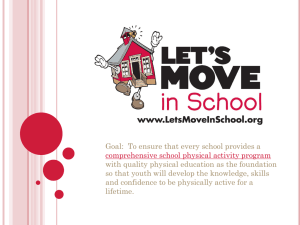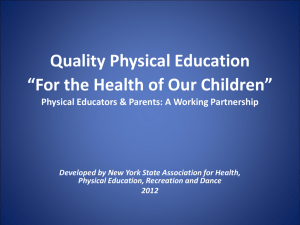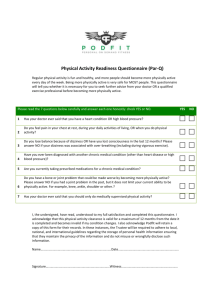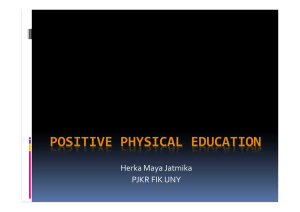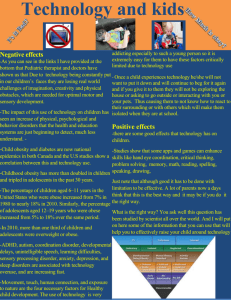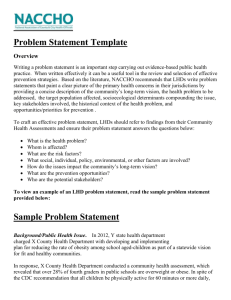Quality Physical Education *For the Health of Our Children*
advertisement
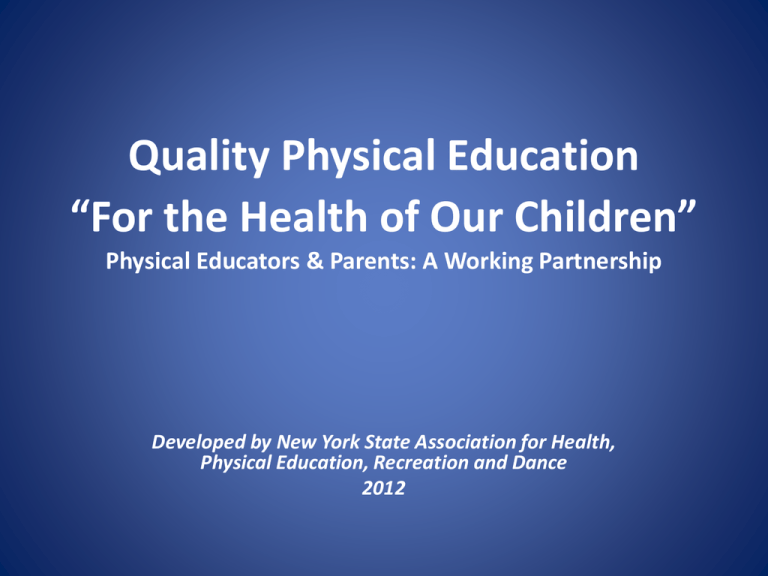
Quality Physical Education “For the Health of Our Children” Physical Educators & Parents: A Working Partnership Developed by New York State Association for Health, Physical Education, Recreation and Dance 2012 WHY DO CHILDREN NEED PHYSICAL EDUCATION? Physical education MUST be an integral part of the total education of every child in Kindergarten through Grade 12 GOALS OF PHYSICAL EDUCATION • To produce physically fit youth • To teach the relationship between physical activity, physical fitness, and good health • To promote the skills, knowledge, and attitude to help children lead active, healthy, and productive lives as adults. —from Louis W. Sullivan, M.D., U.S. Secretary of Health and Human Services What Parents Can Do To Help… Physical Education teachers want what you want to empower your child to lead a healthy, happy, successful and productive life. We can do that by ensuring that your child learns what they need to know to achieve these goals. What Parents Can Do To Help… • Support and encourage your child's participation in appropriate, enjoyable physical activities in and out of school • Be a physically active role model for your child and participate in family activities that include physical activities A Physically Educated Person The National Association for Sport and Physical Education defines a physically educated person as someone who: • Is physically fit • Participates regularly in physical activity • Knows the implications of and the benefits from involvement in physical activities • Values physical activity and its contribution to a healthy lifestyle Research Donnelly and Lambourne 2011 • Physically active; aerobically fit children perform better in school • Children who are physically active during the school day perform better on standardized test • Opportunities for students to learn to manage personal and community resources Research conclusions from the report of the Surgeon General of the United States, 1996 • All children benefit from regular structured physical activity • Through daily activity, children can improve & maintain the health & quality of their lives • Greater amounts of physical activity produce greater health benefits Research • Physical activity reduces the risk of premature coronary heart disease, hypertension, colon cancer, and diabetes • Physical activity improves mental health and is important for the health of muscles, bones, lungs, and joints • Physical activity reduces stress, helps control weight, and is a valuable use of leisure time Did You Know? Evidence shows that physically active students have better learning readiness, attention, fewer behavior issues, and ultimately better academic outcomes. (CDC. The association between school based physical activity, including physical education, and academic performance. Atlanta, GA: U.S. Department of Health and Human Services; 2010.) Did You Know? • Children and adolescents need 60 minutes (1 hour) or more of physical activity each day. (CDC. Physical Activity for Everyone; http://www.cdc.gov/physicalactivity/everyone/guidelines/children.html.) Did You Know? Approximately 17% (or 12.5 million) of children and adolescents aged 2-19 years are obese. (From:www.cdc.gov/obesity/data/trends. html; data from the National Health and Examination Survey (NHANES). Did You Know? Overweight or obese youth are more likely than youth of normal weight to become overweight or obese adults. • (From: www.cdc.gov/healthyyouth/obesity/index.htm; citation: U.S. Surgeon General. Overweight and Obesity: Health Consequences. Rockville: MD; 2001.)
